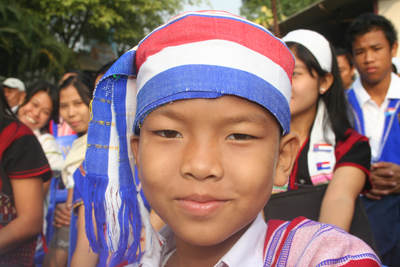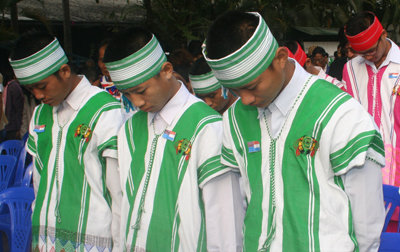KAOWAO - The large crowd filling the chairs in front of the stage at the recent Karen New year celebrations, held on the grounds of the Mae Towe Clinic, in Mae Sot, rose to their feet in unison to focus their attention on the most venerated symbol of their shared hopes and aspirations for freedom.
The Karen national flag has deep meaning to Karen people, because it has been a rallying point during their decades long armed struggle against the Burmese military.
Many in the audience wore clothing displaying the vivid colors Karen traditional dress has become famous for. But, nine year old Saw Zin Min beamed with pride as his mother helped him wrap his head in a scarf with red, white and blue stripes- the predominant colors in the Karen flag.

The young boy’s sentiment was echoed by Master of Ceremonies, Mahn Shwe Hnin, Headmaster of CDC School, in Mae Sot.
“You have to love your flag and be proud of it,” he said. “If not, maybe one day Karen people will disappear from the world.”
Karen people are proud of the fact that their flag is widely recognized.
Dr. Tee Than Pyar founded The Karen National Association in 1881, becoming its first chairman. Afterwards, Dr. Tee Than Pyar, Sayar San Baw from Thararwaddy served as a chairman between 1930 and 1940. During this period, he and other Karen leaders petitioned parliament for the creation of a Karen flag and national anthem.
That request was not ignored. It was discussed in parliament and voted upon in 1935. The public was invited to participate in a competition to design the new flag.

More than one hundred designs were received. Eventually, three were selected for consideration.
Among the three designs selected, Mann Ba Khin, (BA), won the first prize. He was also a writer in the Karen organization. In his flag design, there was a frog drum (called that because it is covered with frog skin). He said ancient Karen people used the frog drum during war and venerated it. Karen people believed that it's a living thing.
The second winner, Sayar Moe from Taung Oo incorporated a rising sun symbol. He noted the rising sun gave the bright light to all Karen people in the world; and sunlight could erase fear. For instance, if a person in a particular family was sick, other family members were worried, being fearful at night especially. When the daylight came, it could erase the fear. As well, sunlight gives life to all living things. All human beings need sunlight and doctors have even cured patients by exposing them to sunlight, as a medical treatment.
The third winner, Dr. Ba Saw Dwe incorporated the image of a white elephant image in the Karen flag. There was an elephant image on the frog drum. According to his definition, the white elephant is a precious treasure.
Mann Ba Khin, the secretary of the Karen National Association, led a group to incorporate all three elements into the final design, which he sent to the Karen National Association.
In the final design, the color red was used to speak of heroism and perseverance, white for purity and clarity and blue for honesty and peace.

Nine rays of light streaming from the rising sun indicated the nine regions from which the Karen people traced their origins.
The frog drum symbolizes unity in traditional Karen culture.
In 1936, Karen army leaders added two Dohs (rounded seeds) under the frog drum in the Karen flag.
Before Burma gained independence in 1937, Karen people held a Karen New Year celebration in Rangoon. At the celebration, the Karen flag was successfully hoisted in the flag pole and Karen people bowed to it in unity.
When the Karen armed revolution occurred on January 31, 1949, some people from the AFPLF government argued the Karen national flag was the flag of the rebels. After that, the government did not allow the flag to be used. However, some Karen leaders, who would not join the armed revolution, named Sayar Thar Hto and Sayar James Htun Aung and Saw Bel Lay bravely used the Karen National flag during Karen New Year celebrations in Rangoon.
In the different regions of Burma where Karen live, and even abroad, Buddhist and Christian Karen people have used the Karen national flag during Wrist Tying ceremonies, cultural ceremonies, public meetings and especially during Karen New Year.
“I’m very happy and proud to be Karen,” young Zaw Sin Min said, his bright eyes peeking out from under the red, white and blue stripes he is so proud to wear.
------------End---------


